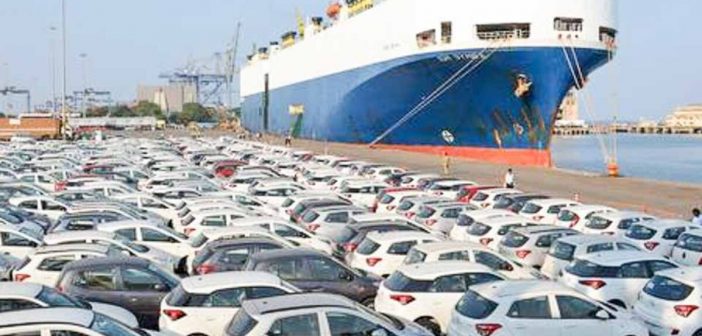India’s automobile industry, a significant contributor to the nation’s economic engine, witnessed a mixed performance in terms of exports during the financial year 2023-24 (FY24). While certain segments like passenger vehicles experienced growth, the overall picture reflected a slight decline compared to the previous year. This article delves into the key trends, achievements, and challenges that defined India’s automobile export journey in FY24.
A Glimpse into the Market: Numbers Don’t Lie
According to industry estimates, India’s total automobile exports in FY24 stood at approximately $13.5 billion. This figure represents a marginal decrease of around 5.5% compared to FY23. While this dip might raise concerns, a closer look reveals a more nuanced story across different segments.
Passenger Vehicles: Shifting Gears into Growth
The passenger vehicle (PV) segment emerged as a bright spot in FY24. Exports of PVs witnessed a commendable growth of approximately 1.4%, reaching an estimated figure of 6.7 lakh units. This growth can be attributed to several factors, including:
- Strong Demand from Emerging Markets: Rising demand for affordable and fuel-efficient cars from markets like Africa, Latin America, and Southeast Asia has benefited Indian carmakers.
- Enhanced Manufacturing Capabilities: Indian automobile manufacturers have made significant strides in improving production quality and cost-effectiveness, making their offerings more competitive globally.
- Focus on Compact SUVs: The growing popularity of compact SUVs in international markets has played in favor of Indian manufacturers known for their expertise in this segment.
Leading the charge in passenger vehicle exports were Maruti Suzuki, Hyundai Motor India, and Kia Motors. These companies have established robust production facilities in India, allowing them to cater to the growing international demand for budget-friendly yet feature-rich cars.
Two-Wheelers: Facing Headwinds
In contrast to the PV segment, two-wheeler exports experienced a decline of approximately 5.3% in FY24, reaching an estimated figure of 34.5 lakh units. This decline can be attributed to several factors:
- Intensified Competition: Global motorcycle giants like Yamaha and Honda have significantly increased their presence in emerging markets, posing a challenge to Indian manufacturers.
- Shifting Market Preferences: In some key export markets like Southeast Asia, a growing preference for scooters over motorcycles has impacted demand for Indian motorcycles.
- Supply Chain Disruptions: Global supply chain disruptions due to chip shortages and rising raw material prices have affected production volumes, impacting exports.
Despite the decline, India remains a prominent player in the global two-wheeler market. Leading manufacturers like Bajaj Auto, TVS Motor Company, and Hero MotoCorp are actively working on strategies to enhance competitiveness, expand product lines, and cater to evolving market preferences.
Commercial Vehicles and Three-Wheelers: A Bumpy Ride
The commercial vehicle (CV) and three-wheeler segments witnessed a more significant decline in exports during FY24. CV exports fell by around 16%, while three-wheeler exports dropped by a staggering 18%. This decline can be attributed to factors like:
- Slowdown in Global Infrastructure Projects: The global economic slowdown has led to a decrease in demand for commercial vehicles used in construction and transportation sectors.
- Shifting Regulations in Key Markets: Stricter emission regulations in some key export markets have necessitated upgrades to vehicle technology, impacting production costs and competitiveness of Indian CVs and three-wheelers.
The future of these segments hinges on technological advancements to meet stricter emission standards and the ability of Indian manufacturers to adapt to evolving global market dynamics.
Beyond Numbers: The Road Ahead
While the overall export figures for FY24 paint a mixed picture, the Indian automobile industry has taken several steps towards strengthening its global position:
-
Focus on Electric Vehicles (EVs): Recognizing the growing importance of EVs, the Indian government and automakers are investing heavily in EV research, development, and manufacturing. This focus on EVs could open up new export opportunities in the coming years.
-
Strengthening Production Infrastructure: Investments in modernizing production facilities and adopting automation will be crucial to enhance efficiency and cost-effectiveness, making Indian automobiles more competitive in the global market.
-
Skill Development Initiatives: Developing a skilled workforce equipped with the latest automotive technologies is essential to cater to the demands of the global market and ensure a future-proof export industry.
Conclusion: A Gear Up for the Future
Despite the challenges faced in FY24, India’s automobile export journey is far from over. The industry possesses immense potential to become a global leader, driven by its strong manufacturing base, skilled workforce, and growing focus on innovation and technology. By addressing existing challenges, exploring new market





